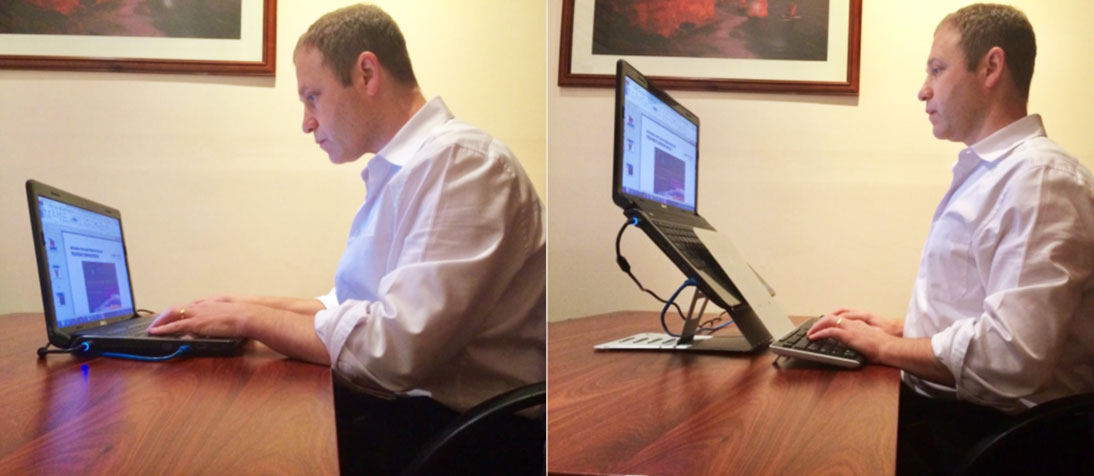
Avoid the Dreaded Tech-Neck – How To Correct Posture Issues As A Result of Extended Mobile Device and Laptop Use
Laptops and mobile handheld devices changed the game when they were introduced to the world. They have made it easier for us to stay connected virtually all day long for whatever purpose, be it social, professional, or recreational. Unfortunately, in as much as these gadgets have made our lives more convenient, they may have also affected our posture for the worse. It certainly doesn’t help that most office jobs tie you down to a sedentary lifestyle, leaving you little room to get up and change your posture. Unless your work requires you to go from place to place, you are likely to be in the same position all day, as you use your gadgets to get on with the day’s tasks.
Believe it or not, that aching neck and throbbing head and those tingling fingers you’ve been experiencing could be because of your stationary posture as you use your laptop. When they were first conceived, laptops were designed as a computer you could literally place on your lap (hence the name), not necessarily a smaller, portable computer that would eventually replace desktops. So it followed that the laptop would be in the bottom part of your typical field of vision, forcing you to shift your gaze down—even if that meant tilting your head downward, making your neck and back follow it as it does. So if you maintain incorrect posture as a result of laptop use and spend most of your time on your laptop—something we’re all undoubtedly guilty of—you could get recurring physical pains that could be debilitating, from sore muscles to repetitive stress injuries. With that in mind, here are a few tips to avoid the shoulder and neck problems that come with excessive laptop use.

Did you know that the amount of force exerted on our heads as we look down on our phones is over 27 kilos? That wasn’t a typo. That’s roughly the same weight as giving a small child a piggyback ride. New York back surgeon Dr Kenneth Hansraj published a study on this a few years ago, in which he used a computer model of the human spine. According to his research, when you tilt your head down to use your phone, the weight of your head increases the gravitational pull on your skull. The average head already weighs between 4.5 and 5.4 kilos. Imagine how much more it weighs when you tilt your head forward. Hansraj calculated the amount of force that the neck goes through when you tilt your head forward. At 15 degrees, around 12.2 kilos is exerted on your neck. It then goes up to 18.14 kg at 30 degrees, 22.23 kg at 45 degrees, and 27.22 kg at 60 degrees. That’s a lot of force on your neck. Now consider that on average, we spend a minimum of an hour on our mobile devices every day. All that force could eventually stress your spine, leading to early wear and tear and degeneration, which could require surgery in the future.
Here are a few tips that could lessen the damage to your neck and spine. After all, we can’t force you to stop using your handheld devices:
Here’s to hoping these tips above lessen the pressure on your neck, shoulders, and back. Not everyone is lucky enough to have a job that isn’t office-bound. But all of us can do our part to lessen our vulnerability to these daily pains and aches brought about by our sedentary lifestyle. And if your computer and mobile phone use has already led you to a bad back and you’re looking for a physiotherapist, make sure your Health Insurance coverage’s got it handled and that you’re able to choose the right one, like us at More Than Physio – call on 9824 8868 or book online on our website.
Taking preventive measures such as those covered in this article will save your neck and back – and probably a lot of money too in the long run. NOTE: We stock collapsible light weight, height adjustable laptop stands as well as many other high-quality products to help you live with better spinal posture.
Give us a call on 9824 8868
Darron Goralsky Principal Physiotherapist & Director
More Than Physio AND Melbourne TMJ & Facial Pain Centre™
1199 High St Armadale Tel 9824 8868

As A Leading Practice in Melbourne's SE for Over 25 Years You can be Confident Our Expert Therapists will Get You The Results You Want